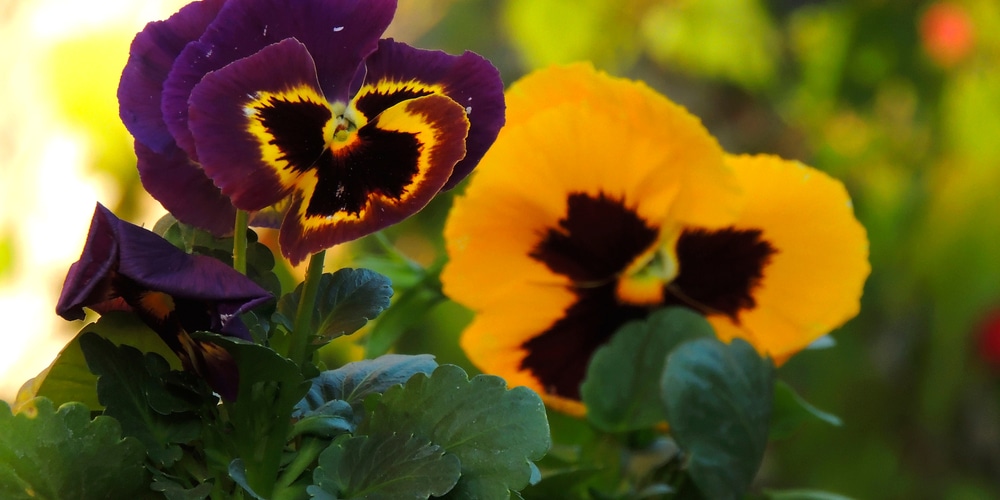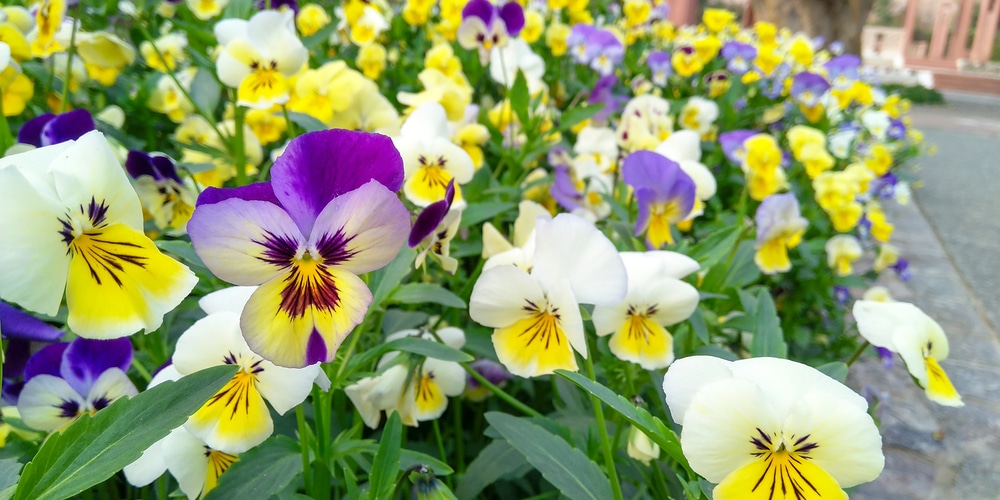The Swiss giant pansy (Viola tricolor var. hortensis) is a beautiful plant that has been a favorite of gardeners for many years. This pansy is one of the most stunning open-pollinated varieties available, thanks to its brilliant colors and large blooms.
As a plant that’s very easy to grow and care for, making it a great choice for both beginner and experienced gardeners alike.
If you are looking for a plant that will add beauty and charm to your garden, then the Swiss giant pansy is definitely worth considering.

| Botanical Name |
Viola tricolor var. hortensis |
| Common Name |
Swiss Giant Pansy |
| Plant Type | Hardy Perennial |
| Flower Color | Blue, Purple, Yellow, Red, White, each with blotches of burgundy in the center |
| Size When Mature |
8 inches tall 4 inches in diameter |
| Bloom Time | Early Spring until Fall |
| Sun Requirements | Partial Sun |
| USDA Hardiness Zones | Zones: 6-10 |
| Soil PH Range | 6.0 – 7.0 |
| Soil Type | Slightly acidic, well-drained |
| Water Needs | Medium |
| Native Area | Europe and Asia |
What You Need to Know About Swiss Giant Pansy
The Swiss Giant Pansy also known as Viola tricolor var. hortensis is vigorous and fast-growing, and it will quickly fill in a bed or border. The flowers are large and showy, and they appear in shades of blue, purple, pink, and white.
The classic Swiss Giants Mix Pansy seeds blend has single hues with blotched faces and a few bicolors. Swiss giant pansies have two petals pointing up and three smaller petals pointing down. The flowers are also held high above the leaves.
The plants are heat-tolerant and disease-resistant, and they will bloom from spring until fall. Whether you are looking for color in your garden or an impressive display in the landscape, the Swiss Giant Pansy is an excellent choice.
It is technically considered a perennial that blooms from October thru May when the weather is mild. This type of pansy can grow up to eight inches tall and 4 inches in diameter. In Addition, its pigmented petals give the flower an additional personality when in contrast with its dark green foliage.
Additionally this plant is also edible with a touch of minty flavor.
How to Care for Swiss Giant Pansy
Here’s everything you need to know about growing and caring for a thriving Swiss Giant Pansy.
Light
The Swiss giant pansy is a perennial plant, meaning it will come back year after year. It has large, fragile-looking flowers that come in a variety of colors, including Blue, Purple, Yellow, Red, and White, each with blotches of burgundy in the center. The Swiss giant pansy prefers partial shade and cool temperatures. It is sensitive to heat and direct sunlight, so it needs to be protected from the harsh rays of the sun.
This type of perennial pansy is perfect for hanging baskets on porches where they are partially hidden from direct sunlight. However, they will put on a show if it is displayed on flower beds and other garden areas.
Water and Soil Needs
These flowers are tolerant of a variety of soil pH levels, they prefer slightly acidic soil that has a pH between 6.0 and 7.0. If the soil is too alkaline, the pansies may produce fewer blooms, and the leaves may develop yellow spots. To ensure that your Swiss Giant Pansies are getting the nutrients they need, it is important to test the soil pH levels regularly and adjust accordingly.
Additionally, these plants are best planted in prepared soil that’s already been watered, with a well-draining mix. Pansies can’t tolerate stagnant water, so make sure the planting area has good drainage.
Temperature Requirements
The Swiss giant pansy (Viola tricolor var. hortensis) is a flowering plant that is native to Europe. It is a member of the viola family, which includes many other popular garden plants such as violets and Johnny-jump-ups.
While it can be grown in a variety of climate zones, it thrives in USDA 6-10. In these zones, the average temperatures are cool enough to allow the plant to flower well and the rainfall is adequate.
The Swiss giant pansy is a member of the Viola family and is related to both violets and pansies. It is a perennial plant, which means that it will come back year after year.
Fertilizer
The best fertilizer to use on a swiss giant pansy is a water-soluble fertilizer. This type of fertilizer will help the plant to develop a strong root system. You can also use a high Phosphorus fertilizer which will help in blooming.
Fertilize the pansies every two weeks during the growing season, using 1/2 teaspoon of fertilizer per gallon of water. Be sure to dilute the fertilizer before applying it to the soil, as too much fertilizer can burn the roots of the plant.
Common Diseases
These plants can be affected by the common root-rotting diseases, including Pythium and Phytophthora. These diseases are caused by fungi that live in the soil and attack the roots of the plant.
To prevent these diseases, it is important to plant the pansies in well-drained soil. If the soil is too wet, the roots of the plant will not be able to get the oxygen they need and will start to rot. If you see any signs of these diseases, such as yellowing leaves or stunted growth, you should remove the affected plant from the soil and destroy it.
Swiss Giant Pansy Propagation
Propagating Swiss giant pansies from seed is a relatively simple process that can be done at home with just a few supplies. First, fill a planting tray with moistened seed-starting mix.
Then, scattered the Swiss giant pansy seeds on the surface of the mix and press them gently into the soil.
Once the seeds have been planted, water the tray thoroughly and place it in a warm location. The seeds should germinate within 10-14 days.
Once the seedlings have sprouted, thin them out so that they are spaced about 6 inches apart. Swiss giant pansies can be transplanted into the garden after all danger of frost has passed.
